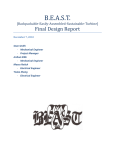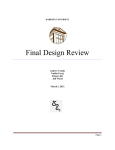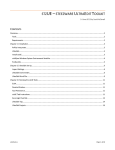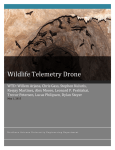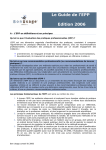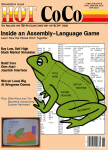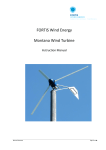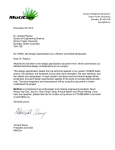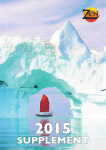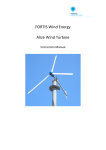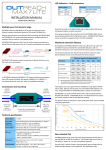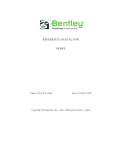Download B.E.A.S.T.
Transcript
B.E.A.S.T. [Backpackable-Easily-Assembled-Sustainable-Turbine] System Design and Project Plan 12 October 2010 Sean Smith - Mechanical Engineer - Project Manager Joshua Gibb - Mechanical Engineer Moses Rotich - Electrical Engineer Yixiao Zhang - Electrical Engineer 1 Table of Contents Background ................................................................................................................................. 3 System Overview ........................................................................................................................ 3 Block Diagram ............................................................................................................................ 4 Functional Description of Blocks ................................................................................................ 5 Organization and Management .................................................................................................... 7 Estimated Budget ........................................................................................................................ 8 Work Breakdown Structure (Fall 2010) ....................................................................................... 9 Work Breakdown Structure (Spring 2011)................................................................................. 11 Gantt Chart (Fall 2010) ............................................................................................................. 13 Gantt Chart (Spring 2011) ......................................................................................................... 14 Network Diagram (Fall 2010) ................................................................................................... 15 Network Diagram (Fall 2011) ................................................................................................... 16 Appendices: Requirements Specification ................................................................................... 17 2 Background Many of us are dependent upon our small electronics ranging from cell phones to laptops for functions varying from information gathering to long distance communication. Unfortunately all of these devices are dependent upon electricity in the form of rechargeable batteries which only last for a set period of usage time and then depend on a steady source of electricity for recharging. On extended stays in areas which do not offer an electricity source, an environmentally-friendly, sustainable, and easily implemented power source is needed. The BEAST will be a solution to that problem intended specifically for long-term trips into remote areas and visits to developing nations where a base camp is required. Military applications and disaster relief efforts are also key markets. The device will consist of a wind turbine that can fit within or on a hiker’s backpack at a reasonable weight, be easily assembled in the field with little technical prowess, and supply enough power to efficiently charge cell phone and laptop batteries. System Overview The finished wind turbine will deliver electricity to a NEMA Type B outlet (standard in U.S. homes) by converting wind energy into mechanical rotational energy and then converting that mechanical energy into electrical energy. The wind energy will be captured by blades that are attached to a hub that is free to rotate. The hub will be elevated on a stand such that the lowest point that the blades spin will be at least 2.14m above the ground. The rotation of the hub will turn the shaft of an electricity generator and thus convert wind energy into electricity. The produced electricity will then be stored in a battery and the battery will supply electricity to an outlet via an inverter. An indicator will tell the user how much power is being produced instantaneously and how much power is available in the battery. The battery pack will also be removable for transportation or use away from the turbine. For the wind turbine to be used the blades must be attached to the hub and the hub must be attached to the top of a collapsible stand. The stand will have sections that are approximately 1m in length and when fastened together achieve a height of at least 2.63m. Each section will have attachment points for tethers that can be attached to the surroundings for stability. The wind turbine and all of its components will be able to be collapsed into a space no greater than 85 liters and weigh no more than 23 kg. During high winds the furling mechanism of the wind turbine will automatically turn it out of the wind so that over-speed of the generator does not occur. Since it may be desirable to disassemble the wind turbine when the wind is blowing it is recommended that a stick or provided tool be used to manually turn the turbine out of the wind to aerodynamically brake the unit. The turbine will be a complete assembly of the turbine, blades, stand, tethers, battery pack and circuitry. 3 System Block Diagram 4 Functional Description of Blocks Stand: Raises the wind-turbine up to more productive winds and keeps the lowest blades at least 2.14 meters off of the ground. The stand provides support in winds up to 20 m/s. Mechanical Housing: The mechanical housing will protect the user from moving parts such as gears, while protecting those moving parts from the environment. It will rotate atop the stand according to the wind direction. Furling Controller: Limits the effective wind speed acting on the blades by turning the blades out of the wind up to 90°. This mechanical controller acts as protection against large wind force and keeps the turbine operating at a safe speed. Inputs: Wind speed (0-20 m/s) and direction Outputs: Effective wind speed from 0-15 m/s Blades: Mounted on the input shaft, the blades convert the effective wind speed into a usable torque. Inputs: Effective wind speed from 0-15 m/s Outputs: 0-750 RPM Gearing: Increases the initial RPM provided by the blades to an RPM suitable for power generation at a ratio of 2:1. Inputs: 0-750 RPM Outputs: 0-1500 RPM Generator: A permanent-magnet DC generator which converts the mechanical energy of the blades into electrical energy. Inputs: 0-1500 RPM Outputs: DC power (0-30V, 0-10 A) Water Resistant Electronics Housing: Provides water resistance to the electronic circuitry. Charge Controller: Converts and regulates the power coming from the generator into a proper power for charging the battery. It also prevents charge backflow and calculates the battery charging rate. Inputs: DC power (0-30 V, 0-10 A) Outputs: DC power (13.5-18 V, 0-3.0 A) 5 Charge Rate Indicator: Displays the rate, in watts, at which the charge controller is charging the battery. Inputs: DC power (13.5-18 V, 0-3.0 A) Outputs: Visualization of the charge rate in watts Battery: A battery which stores at least 200 Wh of energy. Inputs: DC power (13.5-18 V, 0-3.0 A) Outputs: DC power (12 V, 0-18 A) Percent Charged Indicator: Indicates the percent charge available in the battery. Inputs: Voltage (0-12 V) Outputs: Visualization of the percent charge available in the battery On/Off Switch: Determines if the energy available in the battery is to be converted to AC. Inputs: DC power (0-12 V, 0-3.0 A) and human intervention Outputs: If the switch is on then 12 V DC will be allowed through, otherwise no current will be allowed past this point. Power Inverter: Converts the DC into a usable 125 V AC which is supplied to the user via a standard outlet. Inputs: DC power (12 V, 0-18 A) Outputs: AC power (125 V AC, 0-3 A) 6 Organization and Management Sean Smith (Mechanical Engineer) Sean is the project manager and is responsible for ensuring that all of the team members communicate and that the project is completed on time and within budget. Parts ordering and any major design changes must be approved by Sean to ensure that the final product meets the requirement specifications. He is in charge of the generator selection and gearing. He will work in conjunction with Josh on the furling mechanism and blades and acts as the secondary engineering for any component on which Josh is the primary engineer. Joshua Gibb (Mechanical Engineer) Josh will be responsible for CAD drawings and simulation of the wind turbine. He will be in charge of designing and building the housing and stand. He will work in conjunction with Sean on the furling mechanism and blades and with Moses on the electronics housing. Due to his practical knowledge, he will be the lead integration engineer. He is the secondary engineering for any component on which Sean is the primary engineer. Moses Rotich (Electrical Engineer) Moses is responsible for the PCB design for the charge controller and selection of the inverter. He will work with Josh on the electronics housing and with Yixiao on the construction and design of any other electrical components of the system. He is the secondary engineer for any component on which Yixiao is the primary engineer. Yixiao Zhang (Electrical Engineer) Yixiao is responsible for the MULTISIM schematic of the charge controller, the user interface design and construction, and battery selection. She will work with Moses on the design and construction of any other electrical system components as well. She is the secondary engineer for any component on which Moses is the primary engineer. All team members will be responsible for contributing equally to all documentation. Every member is expected to come prepared to contribute to every meeting. Even though each member is assigned specific tasks, it is important to note that all engineers ought to be familiar with each other’s system with the integrated unit as a whole in mind. 7 Estimated Costs Description Battery Part Number/ Specifics SLA battery (12V 18Ah) 6384k344 Set of three Blades injection molded 12V Voltage Regulator, Charge Capacitor, Controller Resistors DC to AC Power DC-AC inverter Inverter GB 46-315 Electrical Cable Electrical cable Ties Receptacle(with Electrical outlet cover) Height/OD (in) Generator Housing Material Hub Material Indicator Steel Spur Gear 443540 PM DC Generator 6061 Aluminum Sheet 6060 Aluminum Sheet Electricity Power Monitor LED indicator Paracord for stand ties Professional Circuit Board LED Encasement Rectifier Rectifier Diode Price 0.375 46 in rotor diameter Total 1 $40.00 2 $11.24 1 $125.00 $26.00 Amazon.com 1 $26.00 $15.00 Amazon.com 1 $15.00 $16.00 Amazon.com 1 $16.00 2 $19.60 1 $149.00 Lab room 1.17 $9.80 SDP-SI.com windsteam $149.00 power.com 24 24 0.125 $48.08 McMaster-Carr 1 $48.08 12 12 0.125 $26.29 McMaster-Carr 1 $26.29 $26.00 Amazon.com 1 $26.00 2 $8.00 2 $7.30 1 $51.00 2.5 3.8 $4.00 Lab room campingsurvival. $3.65 com $51.00 expresspcb.com $0.98 Amazon.com 6 $5.88 $16.38 McMaster-Carr 1 $16.38 4 $20.40 metalsdepot.com 1 $20.40 0.125 4 $25.52 metalsdepot.com 1 $25.52 0.125 4 $29.44 metalsdepot.com 1 $29.44 Shaft Material 12 O1 Steel 0.25 Tube, Square 1.5 1.5 0.125 Tube, Square 1.75 1.75 Tube, Square 2 2 Total Available Funds Current Total Expenses Funding Left Quantity $5.62 McMaster-Carr http://www.defen der.com 100 Circuit Board Location $40.00 Amazon.com Bearing, DS, F Gears Width/ID Thickness Length (in) (in) (ft) $1,000 DS = Double Sealed OD = Outside Diameter $666.13 $333.87 F = Flanged 8 ID = Inside Diameter Work Breakdown Structure Fall 2010 ID F1.00 F2.00 F3.00 F4.00 F5.00 F6.00 F7.00 F7.10 F7.11 Task Description Deliverables Ens ure that the team i s Project Management on schedule and under budget Keep records of al l Documentati on des ign work, research and tests Start/Stop People* Constrai nts and Aug 23-Dec 10 S specificati ons met Documents. Engineering Notebooks Verbal Make a fi nal choi ce of Project Selection confirmati on with which proj ect to pursue profess ors Techni cal descri ption Project Specifi cation Document of the project's goals Techni cal Description of the systems System Desi gn Report Document operation, project pl an, and budget Techni cal Description System Desi gn and of the systems Project Pl an Formal Pres entati on operation, project pl an, Presentati on and budget Design the Detail ed desi gn of Component Design subcomponents subcomponents Detail ed desi gn of Design of Mechani cal Mechanical Design mechani cal Systems components Sel ect a sui tabl e Product number, Generator generator for wind reas oning, Selection generati on specificati ons Aug 23-Dec 10 S, J,M,Y Aug 23-Sept 7 S,J,M,Y Sept 8 -Sept 28 S,J,M,Y Sept 29-Oct 12 S,J,M,Y Oct 14 S,J,M,Y Sept 29-Nov 30 S,J,M,Y Sept 29-Nov 30 S,J Sept 29-Oct 12 S Blade Design Design or find blades sui tabl e for the generator Detail ed desi gn, CAD drawing Oct 13-Nov 2 S,J F7.13 Gear Design Design a gearing system to bring i ncreas e the Detail ed desi gn, RPM's to the rated RPM CAD drawing of the generator Nov 3-Nov 16 S F7.14 Housing Design Design a housing for Detail ed desi gn, the gears and generator CAD drawing to sit atop the stand Nov 17-Nov 30 J F7.12 F7.15 Furling Design F7.16 Stand Design Design a mechanical controller to l imit the maximum wi nd speed of generati on Design a stand whi ch wil l raise the windturbine up to better winds and keep the lowest bl ades from passing wi thin 2.14 meters of the ground Detail ed desi gn, CAD drawing Oct 13-Nov 16 S,J Detail ed desi gn, CAD drawing Nov 3-Nov 30 *S-Sean, J-Josh, M-Moses, Y-Yixiao 9 J F7.20 Electrical System Design Design the electrical system which stores Detailed design of and supplies the electrical system Sept 29-Nov 23 M,Y,J* generated power to the components user Select a light-wieght, Detailed design, durable battery capable product number Sept 29-Oct 12 Y of storing 200 Wh of and specifications energy F7.21 Battery Selection F7.22 Regulates and converts the generated power Detailed design, Charge Controller into power suitable for schematics charging the battery F7.23 Power Inverter Converts the DC power Detailed design, in the battery into 125 V schematics AC for the user Sept 29-Oct 19 M F7.24 User Interface Outlet, On/Off Switch, Charge Rate Indicator, Charge Amount Indicator Oct 27-Nov 9 F7.25 Electronics Housing Design a box to protect the electronic Detailed design, components from CAD drawing weather Nov 10-Nov 23 M,J Detailed design, schematics Sept 29-Oct 26 M,Y Y F8.00 Final Design Report Final system and subsystem design Document Nov 9-Dec 7 S,J,M,Y F9.00 Final Design Formal Presentation Presentation of final design Presentation Dec 10 S,J,M,Y *S-Sean, J-Josh, M-Moses, Y-Yixiao 10 Work Breakdown Structure Spring 2010 ID Task Project S1.00 Management Description Deliverables Ensure that the team is on schedule and under budget Keep records of all design work, research and tests Constraints and specifications met Documents. Engineering S2.00 Documentation Notebooks Working Parts components/meet S3.00 Assembling of components Assembly/Testing specifications documented Working Mechanical Assembly of mechanical components/meet S3.10 Systems components specifications documented Working Generator Test the generator's output components/meet S3.11 Testing for given RPM's specifications documented Working Assemble the gears and components/meet S3.12 Gear and Shaft shaft and test the ratio specifications documented Working Mechanical Construct the housing for components/meet S3.13 Housing the gears and generator specifications documented Working Blade Construct the blade mount components/meet S3.14 Mounting and mount the blades specifications documented Working Construct the mechanical components/meet S3.15 Furling controller specifications documented Working S3.16 Stand Construct the stand component/meets specifications Working Electrical Assemble the electrical components/meet S3.20 Systems components specifications documented Working Construct and ensure that Charge components/meet S3.21 the charge controller Controller specifications outputs steady DC documented Sean, J-Josh, M-Moses, Y-Yixiao 11 Start/Stop People* Jan 18-May 8 S Jan 18-May 8 S,J,M,Y Jan 18- Mar 11 S,J,M,Y Jan 18- Mar 11 S,J Jan 18-Jan 31 S Jan 18-Feb 7 S Feb 8-Feb 21 J Feb 8-Feb 21 S,J Feb 12-Mar 11 S,J Feb 12-Mar 11 J Jan 18- Mar 11 M,Y,J Jan 18-Feb 21 M,Y *S- S3.22 S3.23 S3.24 S3.25 S4.00 S5.00 S6.00 S7.00 S8.00 S9.00 S10.00 S11.00 Working Construct and test the components/meet Power Inverter conversion from 12 V DC to specifications 125 V AC documented Working Test the indicators, components/meet User Interface switches, and outlet specifications documented Working Perform a runtime test on components/meet Battery Testing the battery to ensure specifications capacity documented Working Construct weather resistant components/meet Encasement encasement and test specifications documented Project Status Present the status of the Report Formal Presentation project Presentation System Combine the components Complete system Integration Test system for technical System Testing Fully functioning specifications; modify as and Modification prototype needed Acceptance Tests Prove that the device meets Monitored testing Complete specifications Describes how to use the User's Manual device along with any Document special considerations Final report on the Final Report Document prototype Final Project Presentation about the Formal Presentation prototype Presentation Engineering Combined presentation of Presentation Showcase prototypes Sean, J-Josh, M-Moses, Y-Yixiao 12 Jan 18-Feb 7 M* Feb 8-Feb 28 Y Feb 14-Feb 28 Y Mar 1-Mar 11 M,J Mar 10 S,J,M,Y Mar 14-Apr 10 S,J,M,Y Apr 11-Apr 28 S,J,M,Y Apr 28 S,J,M,Y Apr 20-May 3 S,J,M,Y Apr 13-May 3 S,J,M,Y 5-May S,J,M,Y 8-May S,J,M,Y *S- 13 14 15 16 Appendix: Requirements Specification Backpackable Easily-Assembled, Sustainable Turbine (BEAST) Requirements Specification Sean Smith, Josh Gibb, Moses Rotich, Yixiao Zhang Overview: Many of us are dependent upon our small electronics ranging from cell phones to laptops for functions varying from information gathering to long distance communication. Unfortunately all of these devices are dependent upon electricity in the form of rechargeable batteries which only last for a set period of usage time and then depend on a steady source of electricity for recharging. On extended stays in areas which do not offer an electricity source, an environmentally-friendly, sustainable, and easily implemented power source is needed. The BEAST will be a solution to that problem intended specifically for long-term trips into remote areas and visits to developing nations where a base camp is required. Military applications and disaster relief efforts are also key markets. The device will consist of a wind turbine that can fit within or on a hiker’s backpack at a reasonable weight, be easily assembled in the field with little technical prowess, and supply enough power to efficiently charge cell phone and laptop batteries. The Deliverables 1. Working wind turbine 2. System Specifications 1. Code and electric schematics/MULTISIM 2. CAD drawing 3 Testing report 4. Users’ manual 5. Final Report Principles of Operation The user will assemble the turbine onto a tripod and securely fasten it to the surroundings. The blades of the windmill will capture energy from available wind and use it to turn an electric generator. An energy storage device will capture the generated electricity, allowing the captured energy to be used at the convenience of the user. A standard United States (NEMA type B) AC outlet (the type typically used in household applications) will be attached to the 17 energy storage device. The charge amount and generation rate will be displayed to the user. The user can then choose to detach the energy storage device from the turbine and use it offsite or charge their device while the storage device is still attached to the turbine. Input: The input will be whatever wind energy is available. The system will start generating given at least a 4 m/s breeze and be able to handle wind gusts up to 20 m/s and then stop generation in order to protect the internals of the device. Output: The turbine will be rated to produce at least 15 W given a 6 m/s wind speed at sea level. The energy storage device will contain at least 200 Wh of energy (enough to charge about three typical laptops) and an inverter will be used to supply 125 VAC 60Hz through a NEMA Type B outlet. Technical Requirements 1. Power Generation: The generator should produce at least 15 W given a 6 m/s wind (typical ground level wind speed) and 130 W at 12 m/s (the typical wind speed used to rate wind turbines). 2. Power Storage: At least 200 Wh will be stored in a durable and safe energy storage device. This will provide enough energy to charge three typical 6-cell laptop batteries. The storage device will be detachable and portable for use away from the turbine. 3. Electrical Safety: When the storage device is full, electricity will cease being supplied to the storage device. All wires and circuitry will be able to handle the maximum amount of current produced by the turbine. 4. Mechanical Safety: The mechanical parts will be stable and able to withstand the high shear and bending stresses placed upon them. A housing will cover the gearing and the turbine in order to protect the user. The lowest point at which the blades spin will be at least 2.14 meters off of the ground. 5. Portability: The turbine and all of its components should fit within a large backpacking backpack (85 + liter) and weigh less than 23 kg. It should be easily assembled within an hour after one practice trial by two individuals who have read the user manual using only basic tools (screwdriver, wrench, etc.). 6. Durability: The system will be able to withstand frequent assembly and dis-assembly and still be operational. The electrical components will be contained in a water-resistant housing. 7. User Interface: The rate at which the energy is being produced and the amount of charge available (empty to full) in the energy storage device will be indicated. A 125 VAC 60Hz NEMA Type B outlet will connect devices to the storage device. 18 Testing Plan: 1. The wind tunnel in the Ulrey will be used to supply a 6 m/s, 12 m/s, and 20 m/s wind speed to the turbine. The current and voltage going into the battery will be measured at each of those speeds. 2. The battery will be fully charged and then drained with a run-time test. 3. The wind speed will be increased to 20 m/s to check for mechanical stability of the blades and hub. A force that simulates the maximum force applied under peak operating conditions will be manually applied at the hub while the stand is fully assembled and anchored, in order to check for the stability of the stand. 4. The entire device will be weighed, disassembled, and placed in a backpack. Three separate groups of two volunteers will assemble the device with any necessary tools supplied. The average of the completion times of the second attempts must be one hour or less. 5. The device will be assembled and dis-assembled several times to check for durability. The water resistant electronics housing will be tested while empty by measuring the relative humidity inside, then spraying it with water, and then measuring the relative humidity again. If the relative humidity increases by less than 20% relative humidity it passes the test. 6. The indicators will be tested before final installation by measuring known values using them. A multimeter will be used to verify the outlet’s output while a laptop and a cell phone are being charged individually. 19



















